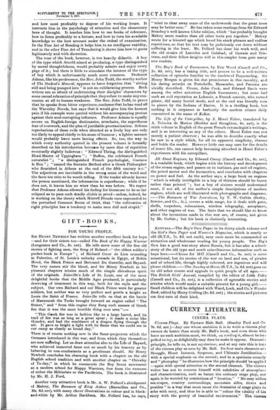GIFT -BOO KS.
FOR YOUNG PEOPLE.
Sin Hmenv NEWHOLT has written another excellent book for boys —and for their sisters too—called The Book of the Happy Warrior (Longmana and Co., 6s. net). He tells anew some of the fine old stories of fighting men, the Song of Roland—'• the oldest soldier's pocket-book in Europe " ; of Richard emir tie Lion crusading in Palestine, of St. Louis's unlucky crusade in Egypt, of Robin Hood, the Black Prince and Bertrand Du Guesclin, and Bayard. The very names stir the blood, and Sir Henry Nowbolt in his pleasant chapters retains much of the simple chivalrous spirit of the originals. Joinville's Life of St. Louis, one of the most delightful books that the Middle Ages produced, is particularly deserving of treatment in this way, both for the style and the subject. Our own Richard and our Black Prince were far greater soldiers, but neither was so very perfect and gentle a knight as Louis the Saint of France. Joinville tells us that at the battle of Mansourah the Turks brought forward an engine called " The Stoner," and " from this engine they flung such messes of Greek fire that it was the most horrible thing ever seen " :—
"This Greek fire was in fashion like to a large barrel, and its trail of fire was as long as a great spear ; it made a noise like thunder, and had the semblance of a dragon flying through the air. It gave so bright a light with its flame that we could see in our camp as clearly as broad day."
There is of course nothing new in the flame-projectors which the Germane introduced in this war, and from which they themselves are now suffering. Let us draw attention also to the Life of Bayard, who achieved immortal fame not so much by his bravery as by behaving to non-combatants as a gentleman should. Sir Henry Newbolt concludes his charming book with a chapter on the old English school tradition and with another chapter on " Chivalry of To-day," in which he commends the Boy Scout movement as a modern school for Happy. Warriors, free from the excesses of either the Militarists or the Pacificiste. The book is illustrated by Mr. H. J. Ford.














































 Previous page
Previous page